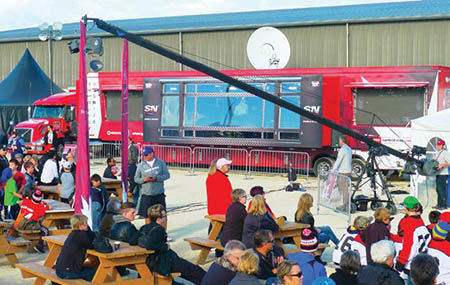Dejero Delivers Hometown Hockey Action
TORONTO —Is there anything more Canadian than hockey? It’s a good bet that you’ll find serious fans and players in every city, town, and arena throughout Canada— all with great stories to tell. With the 25-city Rogers Hometown Hockey Tour—which includes a weekend of hockey activities— we’re bringing that grassroots hockey lore to a national audience.

Crews ready the Rogers Hometown Mobile Studio for another remote event. To launch the tour, we had some specific technical goals. At the top of the list was the creation of a seamless video link between the Hockey Central studio at our main broadcast center in Toronto and our mobile broadcast facility. Rather than rely on traditional satellite and microwave links, we decided to enlist state-of-the-art IP video transmission capabilities from Dejero.
Commonly used for mobile newsgathering and remote broadcasting, Dejero’s VSET transmitter provides a reliable and high-quality IP video link over locally available public Internet and the Rogers cellular network. This enables the show host to interact with our on-air team in Toronto as if they were all in the same room. The Dejero offers extremely high picture quality, sub-second latency, and adapts to available local networks. Should the wired Internet connection fail, we have redundant connectivity via Rogers’ LTE network. In some of the more populated areas, we can achieve bandwidths of 25 Mbps or more, but the efficiency and adaptability of the Dejero technology allows us to obtain a very respectable HD picture quality with as little as 5 Mbps in areas where service infrastructure is limited.
FASTER THAN SATELLITE
We’ve installed a VSET and a Dejero Live+ Broadcast Server in the Toronto broadcast studio and the “Hometown Hockey Mobile Studio,” where host Ron MacLean broadcasts an NHL game at the end of the weekend. In the trailer, the Live+ broadcast server receives the live transmission from the Toronto VSET and displays the video on a monitor for the host’s use. Meanwhile, video from the four broadcast cameras are muxed together along with perspective audio over a satellite path to the production studio in Toronto. The Dejero actually delivers the return studio feeds to the trailer faster than the satellite link. This saves precious time and awkwardness with the delayed responses that happen when talent converses over great distances using traditional technologies. In the near future, as infrastructure and technologies mature, we will be able to use a remote VSET to capture the Hometown Hockey Tour feeds and transmit them back to Toronto.
BUILT-IN BACKUP CONNECTIVITY
As with Dejero’s other IP transmission solutions, a travelling Dejero Live+ 20/20 transmitter provides the ability to send alternative content back to Toronto with the flexibility we need to handle any network contingency. In areas where cell service is not sufficiently adequate to ensure pristine video quality, the Live+ 20/20 transmitter can bond the signal with local Wi-Fi or Ethernet connections. Wherever the Hometown Hockey Tour roams, we’re always assured of a strong and reliable pipe for receiving and transmitting a low-latency, high-quality signal.
The Hometown Hockey Tour is just the latest in a long series of highly successful deployments of Dejero solutions across the entire Rogers Media ecosystem. For several years, Rogers has relied on solutions such as the VSET and the Live+ mobile transmitter to deploy news teams in unique, affordable and flexible ways.
Keith Beaulieu is director of special events/technical design and manager of engineering for Rogers Media. He may be contacted atkeith.beaulieu@rci.rogers.com.
The professional video industry's #1 source for news, trends and product and tech information. Sign up below.
For additional information, contact Dejero at 866-808-3665 or visitwww.dejero.com.
